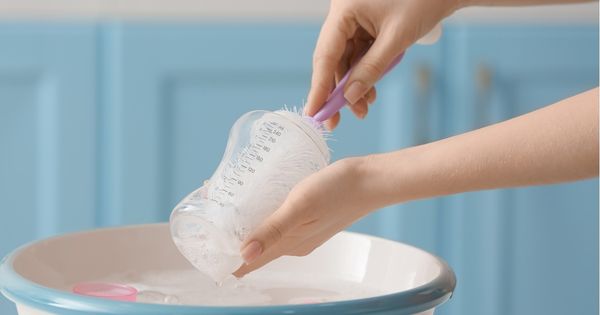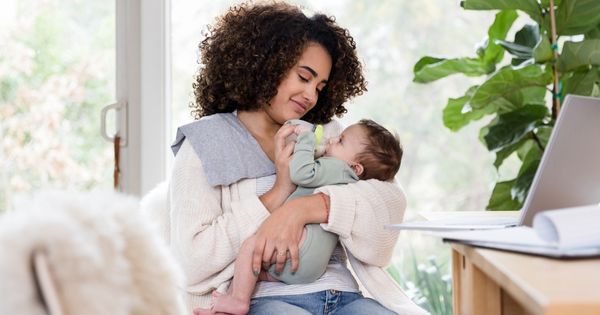Sterilizing baby bottles is an additional step in cleaning that helps with eradicating excess germs that still remains after washing. It is imperative to keep your baby’s bottles clean to keep their still developing immune system working as it should and healthy. It is advised to sterilize baby bottles until your baby has turned one years old, to be on the safe side. So, what are the recommended ways to sterilize baby bottles?
And it is possible that you might have asked yourself this question before when it comes to sterilizing baby bottles – can you sterilize with bleach? In this article we will be sharing the different sterilization methods as approved by the CDC, and we will answer your question. So, keep reading to find out more.

Sterilizing Baby Bottles
According to the Centers For Disease Control and Prevention (CDC) it is necessary to sterilize baby bottles at least once a day to eliminate excess germs that still linger after washing. It is up to you how regularly you sterilize, and in some cases, it is not even necessary. If you have access to treated, clean municipal water, then it won’t be necessary to sterilize your baby’s bottles very frequently. Sometimes sterilizing baby bottles too regularly might end up damaging them.
When Is It Crucial To Sterilize Your Baby’s Bottle?
In these instances, it is essential to sterilize your baby’s bottle:
- Infants that are younger than three months old who still have fragile immune systems. Once he is older than three months, you can still sterilize, but not as frequently, unless your baby has certain health concerns.
- Premature babies also have vulnerable immune systems and sterilizing their bottles regularly adds another layer of protection against germs.
- Babies with certain health issues that compromise their immune system. For them sterilized baby bottles are particularly vital.
- Using new bottles for the first time. You never know where and how the bottle was handled throughout the manufacturing and packaging stages. Always wash and sterilize new bottles before you start using them.
- Sterilize borrowed, previously-used (with siblings), or second hand baby bottles before using it for the first time. You do not know how the bottle was handled or to what it was exposed while in storage. It is always best to be safe rather than sorry.
- Babies who are sick or have just recovered from being ill – you cannot risk re-infecting your little one by using a bottle that has lingering germs. Rather sterilize the bottle after every use while your baby is ill.
- Babies who attend daycare facilities – your baby comes in contact with various people and other children at the daycare. It is good practice to wash and sterilize your baby’s bottles every time he returns from day care.
- If clean drinking water is not accessible at your home – if your water supply is compromised in any way or you don’t have treated municipal water at home, it is best to wash and sterilize your baby’s bottle every time after use.

Different Baby Bottle Sterilization Methods
There are various ways that you can use to sterilize your baby’s bottles.
Using A Microwave
To use a microwave for sterilizing baby bottles, do the following:
- First check if the microwave is clean.
- Fill all the bottles halfway with water.
- Place them inside the microwave.
- Microwave on high for about a minute and half.
- You can also place accessories, nipples, and rings in a glass bowl that is filled with enough water to cover them and microwave for a minute and a half on high.
- Leave bottles to cool down adequately before removing them from your microwave.
Boiling Bottles In Water On A Stovetop
To boil baby bottles in water on your stovetop, do the following:
- Use a large pot with water and place baby bottles inside.
- Push down the bottles that are not submerged and floating on the surface. You can use a spoon to place on top of them.
- Put the pot on the stovetop and switch on the burner or stove plate.
- Once the water reaches boiling point, set a timer for ten minutes.
- Remove bottles and other accessories after ten minutes, using clean tongs.
- Place them on a bottle drying rack.
Before using the boiling method, be sure to check the manufacturer’s details to make sure the bottles will not be harmed. Plastic bottles can melt, or glass bottles might crack if they are not designed to withstand this heat level. Pacifiers and nipples could also break down more easily.
Sterilizing Baby Bottles With An Electric Steam Sterilizer
If you have plenty of countertop space, then an electric steam baby bottle sterilizer can come in very handy.
- Put the baby bottles in the sterilizer.
- Pour in water according to the instructions.
- Press start.
Sterilizing Baby Bottles With UV Sterilizer
This might be the easiest method of all. Viruses, bacteria, and germs are eradicated using the power of UV light.
- Place the baby bottle inside the UV sterilizer and press start.
- Portable UV sterilizers are especially useful while traveling.
Washing Baby Bottles In The Dishwasher
This method might not be suitable for all since some dishwashers do not produce a high enough heat for sterilizing baby bottles.
Make sure your dishwasher has a sanitizing cycle and comes with an NSF/ANSI Standard 184 certification. If it does, you can use it for sanitizing your baby’s bottles.
- Put baby bottles in the top rack of the dishwasher.
- Place any pacifiers, nipples, rings, or other accessories inside the dishwasher basket.
- Run the sanitize cycle.

Can You Sterilize Baby Bottles With Bleach?
If you are unable to steam, boil, use a dishwasher, or do not have access to clean water, then the CDC condones using bleach to sanitize baby bottles.
- Fill a container with 4 liters of water.
- Add two teaspoons of unscented bleach to the water and mix well.
- Soak the baby bottles and other accessories for two minutes and scrub with a baby bottle brush.
- After two minutes, remove them with clean tongs.
- Allow items to air dry.
Apart From Baby Bottles, What Else Needs to Be Sterilized?
Anything that goes into your baby’s mouth or that is utilized for feeding your little one must be sterilized. This includes:
- Nipples
- Bottles
- Pacifiers
- Bottle rings and other accessories
- Breast pump parts
- Feeding utensils or accessories
On The Go Sterilizing Of Baby Bottles And Dummies
When you are out and about it is inevitable that your baby will drop his bottle or dummy on the ground, it is a great idea to keep a bottle of SoPure Dummy Sterilizer Spray in your baby bag to quickly and efficiently sterilize your baby’s dummy or bottle teat.
Conclusion
I hope you have found this post helpful and that some of these sterilization methods will be of use to you. Irrespective of the method you select, the first step should be to clean your baby bottles in hot, soapy water to eliminate milk residue. After cleaning and rinsing, you can move on to sterilizing them.
 Kaboutjie SA Mommy Blogs by Lynne Huysamen
Kaboutjie SA Mommy Blogs by Lynne Huysamen





I love my microwave steriliser. did not ever think bleach could be used. interesting read.
I didn’t know either until I saw moms asking about it online, so I researched it and thought it is a great topic!
Never thought of using bleach. I always washed them in hot soapy water and then into the microwaveable sterilizer.
I always wondered if I can use bleach, because I know it’s effective in killing germs, but people warned me against it. Thanks a million for this article.